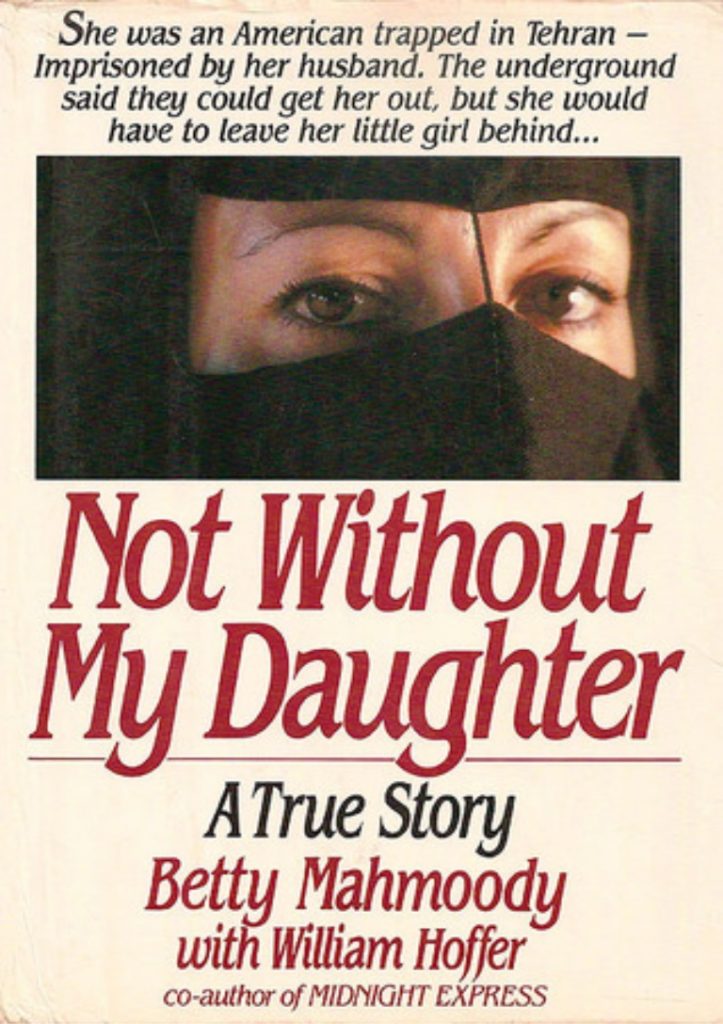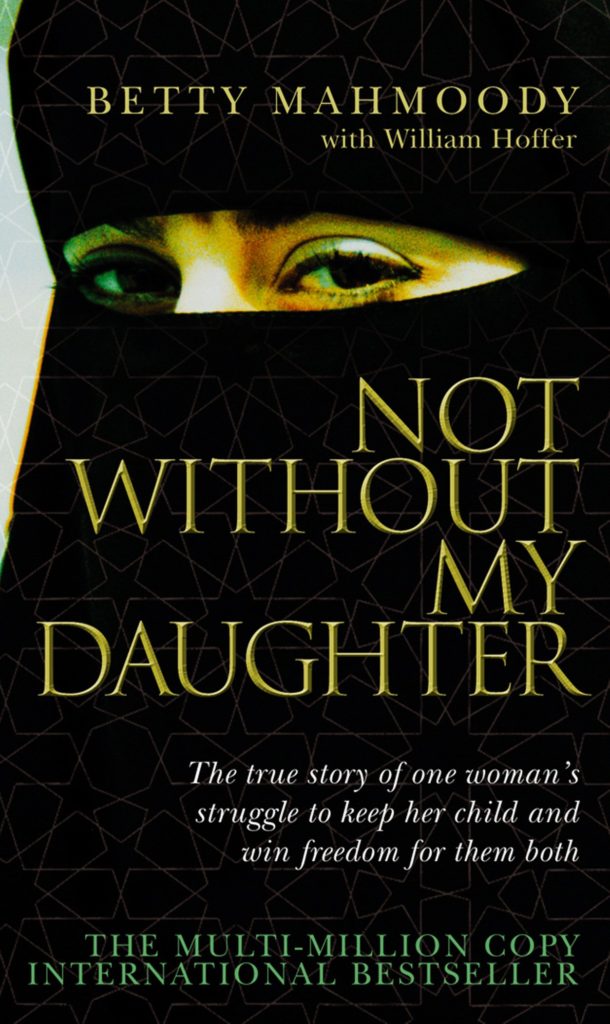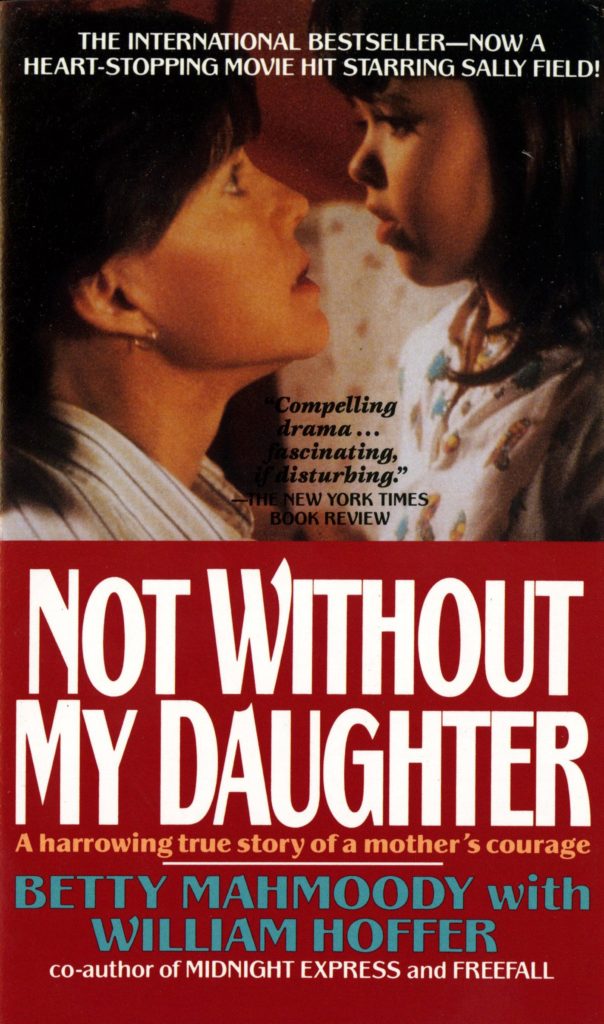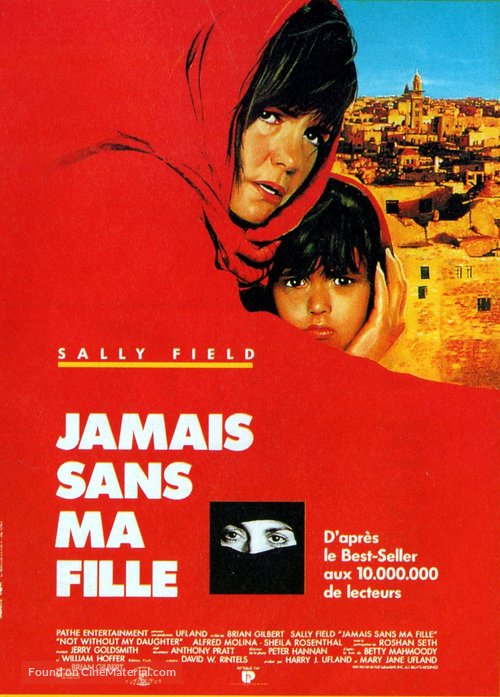Abusing Religion: Race, Islam, and Not Without My Daughter
The second installment in a three-part series about stories of abuse in minority religious communities and how they have influenced American culture
About This Series
Americans are having a moment — which I hope will be more than a moment — in which we are taking stories about women’s sexual coercion and abuse more seriously than in generations past. This is an unsettling and important time to be thinking about women’s stories, and the bedrock of any examination, any dismantling of rape culture, must be this: listen to women.[1] Believe women. Their stories matter. We need to hear these stories.
Sharing stories about sexual abuse is not enough, though. These stories are a call to act, to prevent future abuses from happening. But we don’t act on every story of abuse; only certain kinds of stories, about certain kinds of survivors, seem to actually inspire action.
My book, Abusing Religion (Rutgers University Press, forthcoming), looks at stories about abuse in American minority religious groups. These stories share a common thread: they depict the violation of white American women and children at the hands of religious minorities. And they have inspired massive — indeed, staggeringly disproportionate — responses from the American public through law enforcement, media coverage, targeted legislation, and congressional actions.
Abuse is obscenely common, but few stories of abuse incite raids by armored personnel carriers, news broadcasts that reach millions of viewers, decade-long FBI investigations, or congressional hearings. The stories I write about in Abusing Religion motivated all these responses and more. Americans’ horror and fascination with marginal religions often cause us to correlate religious difference with sexual danger. But we need to take all allegations of abuse seriously, not only the ones that confirm our fears about the danger of sexual and religious difference.
This series for The Revealer introduces three stories of abuse in minority religious communities, how they caught the public’s attention, and why they are still haunting the American religious imaginary. The first installment traced links between Mormon fundamentalists, Jon Krakauer’s Under the Banner of Heaven, and the American public’s fascination with polygyny.[2] This piece considers American Muslims, race, and the “Not Without My Daughter problem.”
***
 Betty Mahmoody’s marriage seemed like a storybook romance: she fell in love with an intense, foreign man (a doctor!) born in Iran but trained in the States, who swept her right off her feet. The sex was great; their marriage was loving; their daughter was beautiful and free-spirited. But the 1979 Iranian revolution disrupted their “normal American lives.” According to Mahmoody, Iran’s political upheaval became “an alien storm…that would shatter my marriage, imprison me…and threaten not only my life, but that of my as yet unborn daughter.”
Betty Mahmoody’s marriage seemed like a storybook romance: she fell in love with an intense, foreign man (a doctor!) born in Iran but trained in the States, who swept her right off her feet. The sex was great; their marriage was loving; their daughter was beautiful and free-spirited. But the 1979 Iranian revolution disrupted their “normal American lives.” According to Mahmoody, Iran’s political upheaval became “an alien storm…that would shatter my marriage, imprison me…and threaten not only my life, but that of my as yet unborn daughter.”
After the revolution, her husband demanded that they visit his family in Tehran. Dr. Bozorg Sayyed Mahmoody promised his wife they would visit for only two weeks. But once there, he took her passport, beat her, and told her they would never leave. Her appeals to the Swiss embassy proved fruitless; her home country was powerless to help her.[3] Fearing for her child’s safety and her own life, Betty Mahmoody smuggled her daughter through the icy mountains of northwestern Iran to escape into Turkey and freedom.
Not Without My Daughter (St. Martin’s Press, 1987) made Mahmoody an international feminist icon, poster girl for women’s liberation from oppressive and notably religious patriarchal abuse. On the surface, this is one woman’s inspiring story of having survived domestic violence against all odds. But the book and its movie adaptation (1991) also fed American biases against Muslims and Islam: portraying her husband, his family, Iranians, and all Muslims as dirty, dangerous, violent, and especially abusive of “their” women.
Stories about Muslims being sexually suspect and abusive toward women are not new to the American religious landscape.[4] At their root, these stories characterize Islam as fundamentally unAmerican and as a threat to women. Published in the aftermath of the Iranian hostage crisis, Not Without My Daughter reinforced convictions that Muslims could never really be Americans, and that contrary to historical evidence Islam had never been, and could never truly be, an American religion. Mahmoody’s work offers us insight into the ways religion and race co-constitute each other in the United States, and conspire to limit “American religion” to white Christianity.
RACE, ISLAM, VIOLENCE, AND AMERICA
We cannot fully understand Americans’ suspicion of and violence toward Muslims if we are not also thinking about race, if we fail to consider American Islam as racialized, if we don’t take into account that, in fact, “Muslim” has always been a racial as well as a religious or religio-racial (to use historian Judith Weisenfeld’s term) identity in the United States.[5]
Religion has played an intimate role in the construction of race throughout American history. In the colonial period, colonizers justified violence toward and exploitation of non-Christians — enslaved or Indigenous precisely because they were not “saved.” Once slave owners began forcing enslaved and Native persons to convert to Christianity, religious difference could no longer justify chattel slavery. This is when we see arguments about the essential, biological superiority of whiteness over all other racial categories emerge — when we see American whiteness created to justify the commodification of Black bodies and the eradication of Native bodies.
 Religion in the United States has also always been a racialized category. While the Founding Fathers went some distance to enshrine religious liberty in the Constitution, the operating definition of what qualifies as American religion has always been informed by white Christian sensibilities. Here again, Black Christianity and Native Christianity needed to be essentially inferior to white Christianity to justify land theft, forced relocation, enslavement, and attempted genocide. These white supremacist attitudes continue to inform Americans’ legal and cultural understandings of “religion.” When Americans speak of “religion” as an undifferentiated, unmarked category, “religion” usually signals “what white Christians do.” That is: American religion is a religio-racial category that assumes both whiteness and Christianity.
Religion in the United States has also always been a racialized category. While the Founding Fathers went some distance to enshrine religious liberty in the Constitution, the operating definition of what qualifies as American religion has always been informed by white Christian sensibilities. Here again, Black Christianity and Native Christianity needed to be essentially inferior to white Christianity to justify land theft, forced relocation, enslavement, and attempted genocide. These white supremacist attitudes continue to inform Americans’ legal and cultural understandings of “religion.” When Americans speak of “religion” as an undifferentiated, unmarked category, “religion” usually signals “what white Christians do.” That is: American religion is a religio-racial category that assumes both whiteness and Christianity.
Islam, of course, is not a race. But as a religion, Islam has been racialized throughout the American experiment as not-white, not (fully) American. Betty Mahmoody’s xenophobic blockbuster reinforced and authorized these longstanding perceptions of Islam as a religion antithetical to America and to whiteness.
To understand why this is, it’s helpful to know a little about the history of American Muslims and Islam in the United States. American Islam is indelibly intertwined with the history of slavery. Islam came to the North American continent with the trans-Atlantic slave trade: the first American Muslims were enslaved people, forcibly taken from their homes in West Africa — a region in which Islam had thrived for centuries — and brought to North America.
The American Muslim population remained relatively small throughout the nineteenth century. Muslims were mostly invoked in Orientalist terms, as anti-Americans, opposed to freedom and civility. Until the mid-twentieth century, Black Muslims were the face of American Islam. The Moorish Science Temple, and later the Nation of Islam, emerged as spaces of remarkable Black religious innovation. Both the Moorish Science Temple and the Nation allowed members to resignify their own Blackness, to locate themselves in histories other than those of oppression and enslavement.
From the eighteenth through the mid-twentieth century, American Islam was coded as Black religion. Immigrants allowed into the country after immigration reform legislation was implemented in 1965 shifted the demographics of the American Muslim population from Black to Brown, as U.S. Muslims were increasingly of South Asian and Middle Eastern decent. In a nation that strongly identifies with white Christianity, American Islam’s connection to Black and Brown-ness, to slavery and immigration, and to a monotheism not centered on Jesus, has led to widespread convictions that Muslims cannot truly be Americans.
THE NOT WITHOUT MY DAUGHTER PROBLEM
During the 1979-1981 Iran hostage crisis, Americans increasingly came to view Muslims as a threat to domestic sovereignty. Not Without My Daughter chronicles the (supposed) dangers and (seemingly) inevitable failures of one Muslim man’s attempts to assimilate to American-ness. Not Without My Daughter narrates at length the inability of Dr. Bozorg Sayyed Mahmoody — or “Moody,” as she calls him throughout the book — to assimilate and his “regression” into both Islam and violence toward women. Mahmoody details her husband’s rapid deterioration from an industrious, virile, and thoroughly Americanized medical doctor into an abusive, impotent lunatic shortly after their family’s arrival in Tehran. Within days, Moody begins threatening both Betty and their daughter.
 Mahmoody links her husband’s violence to his nationality and his religion. Throughout her narrative, she attributes the abuse she suffers not merely to her spouse, but to Iran and Islam. She consistently describes Iranian women as meek slaves, portraying all Muslim men, and the Islamic Republic of Iran, as uniquely oppressive of and violent toward women. She identifies her husband’s Moody’s violence toward her, and what she perceives as Iranian men’s disregard for women in general, as inherently Islamic. The racialization of Muslims throughout American history predisposed Betty Mahmoody’s readers to believe that her Muslim husband was essentially foreign, other-than-American – and essentially violent toward women. Not Without My Daughter characterizes Muslim belonging as a religious, but also a racialized threat, revealing the ways anti-Muslim hostility builds on white supremacy.
Mahmoody links her husband’s violence to his nationality and his religion. Throughout her narrative, she attributes the abuse she suffers not merely to her spouse, but to Iran and Islam. She consistently describes Iranian women as meek slaves, portraying all Muslim men, and the Islamic Republic of Iran, as uniquely oppressive of and violent toward women. She identifies her husband’s Moody’s violence toward her, and what she perceives as Iranian men’s disregard for women in general, as inherently Islamic. The racialization of Muslims throughout American history predisposed Betty Mahmoody’s readers to believe that her Muslim husband was essentially foreign, other-than-American – and essentially violent toward women. Not Without My Daughter characterizes Muslim belonging as a religious, but also a racialized threat, revealing the ways anti-Muslim hostility builds on white supremacy.
Were it not for its sustained influence on the ways Americans presume to understand Islam, Not Without My Daughter could be regarded, at best, as one woman’s story of surviving domestic abuse. But in the three year’s between the publication of Daughter’s and its film release, mainstream Americans were poised to assume Muslims hailed from certain regions and that — following the 1979 Iran hostage crisis and the 1990-91 Gulf War — those regions meant harm to the United States. Metro-Goldwyn-Mayer released the Not Without My Daughter film three days before George H. W. Bush’s deadline for Iraqi soldiers to withdraw from Kuwait, presumably to capitalize on Americans’ anti-Arab sentiment. Sally Field portrayed Mahmoody in this poorly reviewed but oft-referenced adaptation, which still regularly airs on the Oprah Winfrey Network, OWN.
Daughter sold 15 million copies internationally and has been translated into 20 languages. Mahmoody also told her story to Barbara Walters, Larry King, Phil Donahue, Sally Jessie Raphael, and Oprah Winfrey – and through them, to millions of American viewers.[6] The book was selected as a Literary Guild alternate and nominated for a Pulitzer Prize in 1987. Perhaps most strikingly, Mahmoody’s story helped shape US federal law and policy – Mahmoody was the only person to be named in the Senate hearings for a bill which became the International Parental Kidnapping Crime Act. The US State Department appointed Mahmoody as an advisor “on the plight of American women and children held against their will in foreign countries.” Mahmoody’s strongly contested narrative influenced not only millions of readers and film-goers, but also federal law and foreign policy for the world’s largest military state.
That scholars, critics, and former acquaintances have condemned Mahmoody’s narrative as misleading, inaccurate, and racist has done little to stem its lasting influence on Americans’ imaginings of Islam and Iran.[7] Despite its questionable content, Americans frequently cite Not Without My Daughter not merely as a personal memoir of domestic discord, but as an authentic account of contemporary Iranian life. Not Without My Daughter, in its pulp nonfiction and filmic instantiations, enjoyed a near-monopoly on Americans’ imaginings of Iranian culture. Teachers showed the film as a credible example of Muslim beliefs and practices. Comic Maz Jobrani insists that “this movie [Not Without My Daughter] did more to hurt the dating lives of Iranian men in America than the hostage crisis. Many of my friends relinquished any pride they had in their Persian background and just pretended to be Italian.” Sociologist and media personality Reza Aslan joked that the film “absolutely destroyed” his romantic life and “ruined dating for every male Iranian of [his] generation,” because viewing Daughter led American mothers to fear that all Iranian men were secretly abusive toward women.
 Daughter made Iranian/Muslim men monstrous; novelist Porochista Khakpour calls Daughter “a horror movie about Iran,” in which “we [Iranians] were Freddy Krueger.” In January 1997, the judge presiding over a Michigan child custody suit between a European American mother and an Arab American father allowed the mother’s attorney to screen the film Not Without My Daughter as evidence for the father’s parental unsuitability.[8] The affective resonance of the book and the film for late 20th century American audiences cannot be overstated: consumers received this narrative as insight into how Iranians — and Muslims —“really were” at home.
Daughter made Iranian/Muslim men monstrous; novelist Porochista Khakpour calls Daughter “a horror movie about Iran,” in which “we [Iranians] were Freddy Krueger.” In January 1997, the judge presiding over a Michigan child custody suit between a European American mother and an Arab American father allowed the mother’s attorney to screen the film Not Without My Daughter as evidence for the father’s parental unsuitability.[8] The affective resonance of the book and the film for late 20th century American audiences cannot be overstated: consumers received this narrative as insight into how Iranians — and Muslims —“really were” at home.
Stories like the one Betty Mahmoody told are still shaping American attitudes toward Muslims and Islam. Nafisi’s Reading Lolita in Tehran and Ben Affleck’s Argo are two recent examples of this persistent, pernicious genre, both portraying Muslim men as violent, irrational, and hostile.[9]
The sustained popularity of such narratives coincides with intensifying anti-Muslim rhetoric and violence within the United States and an increased American scrutiny of Muslim majority states. For example, the current president of the United States has tried to restrict immigration from Muslim-majority countries three times. Executive Orders 13769 and 13780 both highlight so-called “honor killings” among the justifications for these proposed restrictions. Using “honor killings” to render domestic violence in Muslim families as especially heinous and specifically religious is a standard tactic among anti-Muslim pundits like Pamela Geller.
The Supreme Court recently upheld the president’s third attempt to restrict immigration from Muslim-majority countries. In her dissent, Justice Sotomayor cited a statement the president issued in 2015 “calling for a total and complete shutdown of Muslims entering the United States.” This statement alleges that Islamic law “authorizes… unthinkable acts that pose great harm to Americans, especially women.” In light of recent events, Not Without My Daughter foreshadows nearly half a century of xenophobic stories that demonize Muslim men as violent, racialized, religiously fanatic predators. The anti-Muslim hostility evident in the book and film continues to manifest in American policy, which demonizes Muslims and excludes them from national belonging. Such stories lay plain the co-construction of race and religion and reveal the power of white Christian supremacy in the United States.
***
[1] And other survivors of violence, coercion, and assault, of course. I focus on women’s stories not because they are more important than those of other survivors, but because stories about white women and children being abused are most effective at inciting public response.
[2] Polygamy refers to any marriage of multiple partners and is the most common term used by outsiders to describe Mormon fundamentalist plural marriage. But Mormon fundamentalist plural marriages are exclusively polygynist, marriages of one man to multiple women. Mormon fundamentalist doctrine permits — and in some cases encourages — this form of “plural marriage” while proscribing polyandry, the marriage of one woman to multiple men. See Doctrine and Covenants 132: 54-55.
[3] After the revolution and the pursuant hostage crisis, the United States did not maintain diplomatic ties with the Islamic Republic of Iran. Mahmoody approached the Swiss embassy as a neutral third party.
[4] For example: nineteenth-century anti-Mormon activists used orientalist stories about Muslim harems to discredit the nascent Church of Jesus Christ of Latter-day Saints for its practice of polygyny.
[5] My understanding of religio-racial identities draws directly from Judith Weisenfeld’s germinal New World A-Coming. Weisenfeld offers religioraciality as space in which history, racial identity, and the relationship of religion to racial collectivity enmesh and inform one another (2016, 13).
[6] OWN still airs and promotes the film.
[7] Roger Ebert called the film “racist and prejudiced.” Sylvia Chan Malik provides a scholarly analysis of the film in her article, “Chadors, Feminists, Terror.” See also my article, “They Do That to Foreign Women” (2016).
[8] It’s worth noting that the family depicted in Not Without My Daughter is Iranian, not Arab, making this lawsuit yet another space in which the racialization of Islam (and the operation of anti-Muslim hostility as racism) is apparent.
[9] Reading Lolita sold more than a million copies and spent two years on the New York Times best-seller list. Argo won three Academy Awards in 2012. Before naming Argo 2012’s Best Picture, First Lady Michelle Obama hailed the film as one that “lift[s] our spirits, broaden[s] our minds, and transport[s] us to places never imagined.”
***
Megan Goodwin (PhD UNC 2014) is a scholar of gender, sexuality, race, and contemporary American minority religions. and the Director of Sacred Writes at Northeastern University, a project committed to amplifying the voices of experts who often go unheard in public discourse. Her current book project, Abusing Religion: Literary Persecution, Sex Scandals, and American Minority Religion (Rutgers University Press, forthcoming), explores the coding of religious difference as sexual danger. Her next project considers the ways contemporary American whiteness is (or feels) threatened by Muslims and Islam. Goodwin is the co-chair of the American Academy of Religion’s New Religious Movements Program Unit and a former co-editor of Religion Compass’s Religions in the Americas section.
***
Published with support from the Henry R. Luce Initiative on Religion in International Affairs.